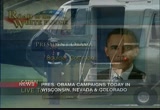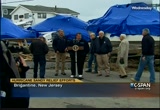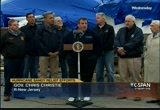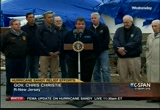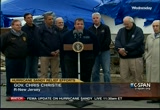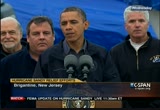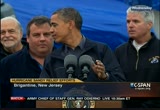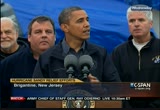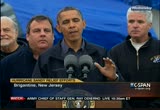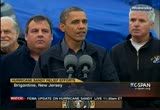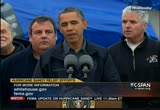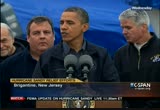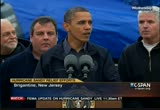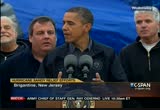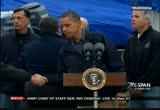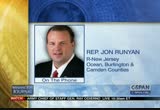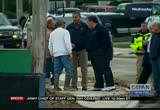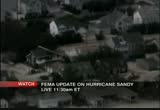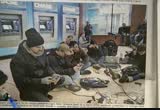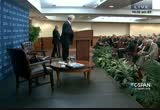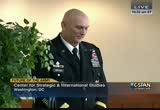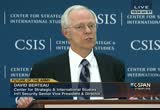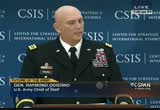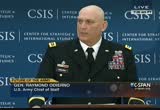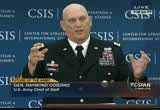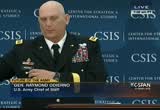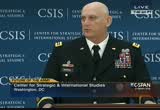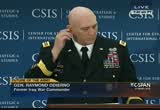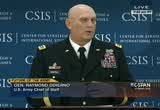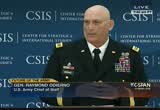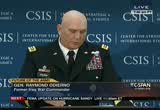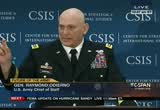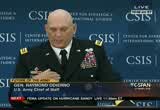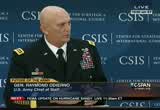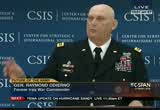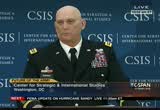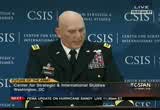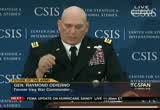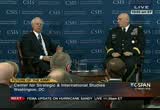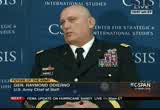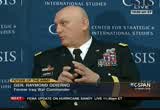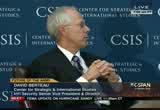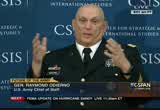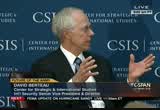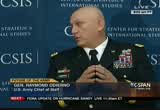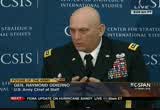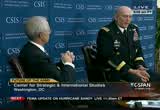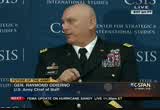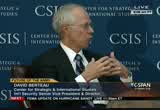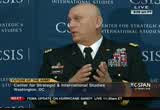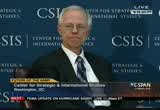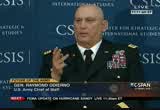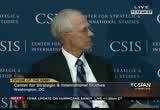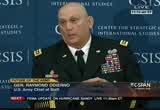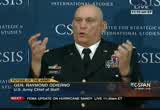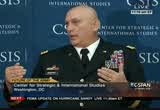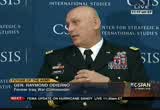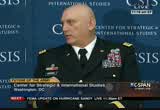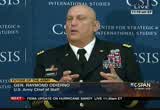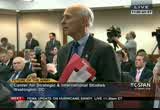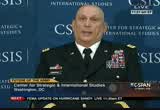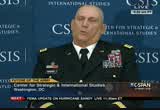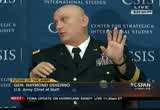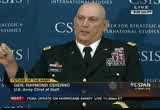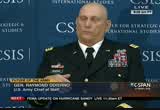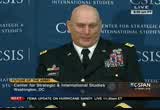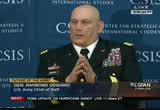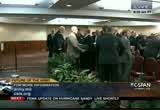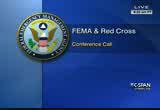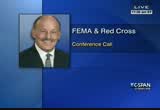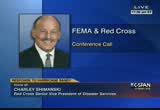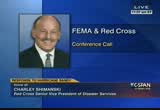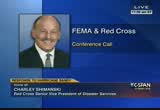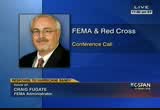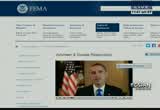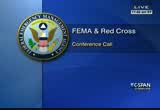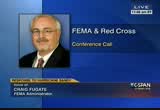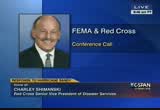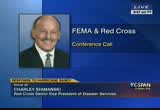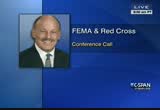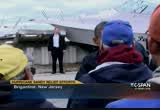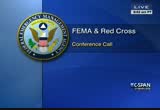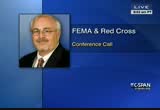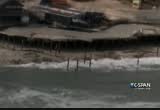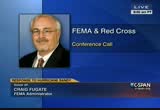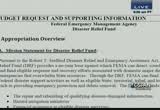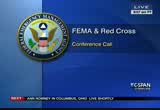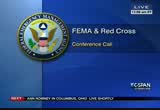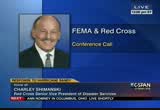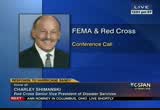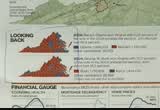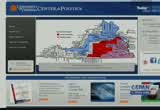tv Public Affairs CSPAN November 1, 2012 10:00am-1:00pm EDT
10:00 am
>> coming up in about a half-hour we'll take you live to the center for strategic and international studies here in washington for remarks by army chief of staff general raymond odierno, former top commander in iraq. talking about the changing structure of the u.s. army. that's set to start at about 10:30 eastern here on c-span. just a short while ago, president obama farthered the white house this morning on his way to wisconsin with just a few days until the election, the president is returning to the campaign trail after placing his campaign on hold for the past few days to manage the federal response to hurricane sandy. the president holds a rally in green bay, wisconsin, this morning before heading west for an eempt later today in las vegas. you can watch both those events live on line at c-span.org. tonight at 9:00 eastern, the president will be speaking to
10:01 am
supporters at the university of colorado in boulderment you can watch that live right here on c-span. mitt romney is campaigning throughout virginia today. he'll be in roanoke, virginia beach, and this afternoon in doswell just outside richmond. c-span will have live coverage of that stop beginning about 2:15. also live a rally with mitt romney's wife ann. that will be at noon eastern. she's speaking with supporters in columbus, ohio. live today at noon here on c-span. president obama yesterday spent the afternoon with new jersey governor chris christi touring the damage across the state's coast left from hurricane sandy after surveying some of the wreckage and speaking with victims of the storm. both men spoke briefly about the coordination efforts between federal and local officials. >> good afternoon, everybody.
10:02 am
thank you-all for coming today. i want to thank the members who are here as well. i want to thank the president. we spent significant afternoon together surveying the damage up and down the new jersey coastline. we were on marine one together, to show the president that personally. we had an opportunity to discuss it at length. then going over to the shelter here, to be able to meet with folks, have them see the president and his concern. the concern all of us have for making sure that things get back to normal as quickly as possible. we have lots of challenges. our challenge now is to get back to normalcy. the things we need to do is make sure we get power restored as quickly as possible. make sure people have clean drinking water and wastewater treatment plants are working, hospitals are taken care of, and we get kids back to school. i discussed all those issues today with the president and i'm pleased to report that he has sprung into action immediately to help get us those things while we were in the car riding
10:03 am
together. so i want to thank him for that. he has worked incredibly closely with me since before the storm hit. i think this is our sixth conversation since the weekend, and it's been a great working relationship to make sure that we are doing the jobs that people elected us to do. i can't thank the president enough for his personal concern and compassion for hur state and for the people of our state, and have full conversation was him and i was able to witness it today personally. state government is here. we are doing what we need to dofment we are coordinating with fema. i want to thank the administrator for being here, for the input he's already had in helping to make our operation betterment we'll move on from here. what i said yesterday i really mean. there's got to be sorrow. you see that in -- and the president has seen that today, in the eyes and faces of the folks he met. that sorrow is appropriate. we suffered some loss. luckily we haven't suffered that
10:04 am
much loss of life and we thank god for that. but we have suffered losses, and this is the worst storm i have seen in my lifetime in the state. but we cannot permit that sorrow to replace the resilience i know all new jerseyans have. so we will get up and we'll get this thing rebuilt and we'll put things back together because that's what this state is all about and always has been all about. for all of you who are here, i met a bunch of you today, who disregarded my admonition, get the hell out of here, you know, you are forgiven this time. you are forgiven this time but not for much longer. we got to ensure when all of you look around and see this destruction, that's fine. you know what? all that stuff can be replaced. you look to your right and to your left, husband, wife, son or daughter, those are the things that can't be replaced. i'm so glad we don't have that kind of loss of life to deal with. i want to thank him for being here today. bringing his personal attention to it. it's my honor to introduce to all of you the president of the
10:05 am
united states. >> thank you, everybody. let me just make sure that i acknowledge the folks who are here because they played an important role in this. first of all your congressional delegation, senator bob menendez, senator frank lautenberg, congressman frank lobiondo, atlantic county executive dennis leavenson, and mayor philip gunther. obviously this is a federal, state, and local effort. and the first thing i want to do is just to thank everybody who's been involved in the entire rescue and recovery process. at the top of my list i have to say that governor kristi throughout this proses is hasegawa been responsive, he's been aggressive in make being sure that the state got out in front of this incredible storm,
10:06 am
and i think the people of nming new jersey recognize that he has put his heart and soul into making sure that the people of new jersey bounce back even stronger than before. so i just want to thank him for his extraordinary leadership and partnership. i want to thank the congressional delegation because part of the reason we are going to be able to respond quickly to all this is because they helped make sure that fema financing was in place. and we are very appreciative of those efforts. i want to thank craig few gate -- fugate, sometimes people just think fema and they don't think the people behind them, but craig lives and breathes this stuff, making sure that we are providing the help that people so desperately need in these situations. i want to thank all the first responders who have been involved in this process. the linesmen, firefighters, folks who were in here shuttling
10:07 am
out people who were supposed to get the hell out and didn't. you helped save a lot of lives and a lot of property and one thing you learn in these tragedies is, the first responders, keep in mind their homes usually are under water, too, or their families have been infected in some way, and yet they make those personal sacrifices to help other people. we really appreciate them. i'm just going to make a couple comments. number one, and most importantly, our hearts go out to the families who have lost loved ones. it's true that because of some good preparation the loss of life was kept lower than it might have been, but for those individual families, obviously, their world has been torn apart, and we need to make sure that everybody who's lost a loved one knows they are in our thoughts and prayers. i speak for the whole country there. for those like the people i just
10:08 am
had the chance to meet on this block and throughout new jersey, and throughout the reasonableon, whose lives have been abandoned, my second message is, we are here for you. and we will not forget. we will follow up to make sure that you get all the help that you need until you've rebuilt. at this point our main focus is on the states of new jersey, which got hit harder than anybody. state of new york for taking away lower manhattan and long island. we are very concerned about some situations in connecticut as well, and we are still monitoring west virginia where there are heavy snows in some inaccessible areas. for the most part those four states are really bearing the brunt of this incredible storm. what we have been able to do is to preposition and stage
10:09 am
commodities, water, power generators, ambulances in some cases, food, medical supplies, emergency supplies, and we have over 2,000 fema personnel on the ground right now. their job now that we are moving out of the search and rescue phase, is to make sure that they are going out and talking to individual communities so that people know exactly how they can get the help that they need. we expedited our emergency declarations for the state of new jersey and local counties that have been affected. what that means is is that people can immediately start registering for emergency assistance. and one of the things i want to emphasize to the people in new jersey and throughout the region, now that you're safe, your family's safe, but you're trying to figure out where you're going to stay for the next couple days, etc., it's
10:10 am
very important that you know that there's help available to you right now to fight rental housing or be able to pay for some groceries. over at the community center we saw a young woman who had a newborn or probably an eight month old still needs diapers and formula and has run out. those are the kinds of basic supplies and help we can provide. if you call 800-621-fema, 800-621-fema, or disaster assistance.gov if you got access to the internet, you can go to disasterassistance.gov, that allows you to register right now so that you can immediately start receiving help. we want to make sure you get everything that you need. a couple of final points, obviously our biggest priority right now is getting power turned back on. we are very pleased that newark got power yesterday, jersey city
10:11 am
is getting power we believe today. but there are still big chunks of the community, including this community right here, that couldn't have -- don't have power, it's hard enough cleaning up debris and dealing with boats that have been upended and roads that are blocked when people don't have power, obviously they are disabled in all sorts of ways, and it's hard to get back to normal. yesterday i had a chance to speak to the c.e.o.'s of the utilities from all across the country, and a lot of the states that were spared, that were not hard hit or some states as far away as california, they have pledged to start getting equipment crews, etc., here into new jersey and new york and connecticut as quickly as possible. and one of the things that we have been able to do, just to give you a sense of how this is an all hands deck approach,
10:12 am
we're able to get c-17's, c-130's, military transport planes potentially to move assets, personnel to speed up the process of getting power up and running as soon as possible. our first priority is water filtration plants and some other critical infrastructure in the state. for that we've got emergency generators. we've got a navy ship that has some helicopters that can help to move assets around the state as well. and so we are going to be working with governor christi's office to identify the critical infrastructure and how we can get what's needed as quickly as possible. a couple other things we are concerned about, one is as power starts coming back on, we want to make sure that people can also get to work. obviously there are a lot of folks in jersey who work in new york, in the city, and in other
10:13 am
places where transportation may be hobbled. one of the things i mentioned to the governor is the possibility of us using federal assets, military assets, as well as taking inventory of assets from around the country that can be brought in so that we can help people get to their work. and governor christi also mentioned the importance of schools. the sooner we can get our kids back in school, the sooner they are back in a routine, that helps the families and helps the kids as well. we are going to have a lot of work to do. i don't want anybody to feel that somehow this is all going to get cleaned up over night. we want to make sure that people have realisic expectations. but what i can promise you is that the federal government will be working as closely as possible with the state and local officials and we will not quit until this is done. and the directive that i have given, i said this yesterday but i will repeat, and i think craig and others who are working with
10:14 am
me right now know i mean it, we are not going to tolerate red tape. we are not going to tolerate bureaucracy. and i instituted a 15-minute rule, essentially, on my team. you return everybody's phone calls in 15 minutes. whether it's the mayor's, governor's, county officials, if they need something, we figure out a way to say yes. just gathering around i had a chance to talk to some of the young people here who have been volunteering, going up and down the block cleaning up debris, and when we were over at the community center, there was a restaurant owner who for the last 18 hours had been cooking meals as his contribution to the recovery process. some of the folks were saying the food was better than they got at home. you had a 15-year-old young man whose mother was disabled and he was making sure that she was ok
10:15 am
and taking on extraordinary responsibilities for himself, but also for his mom. when you see folks like that spopped with strength and resilience, when you see neighbors helping neighbors, then you're reminded about what america's all about. we go through tough times, but we bounce back. and the reason we bounce back is because we look out for one another. and we don't leave anybody behind. and so my commitment to the people on this block, the people in this community, and the people of this state is that that same spirit will carry over all the way through until our work is done. all right. thank you very much, everybody. [applause] [captioning performed by national captioning institute] [captions copyright national cable satellite corp. 2012]
10:16 am
>> this is some of what president obama and chris christi saw yesterday on their tour up the new jersey shoreline by helicopter. their one-hour tour yesterday. the president traveling on the campaign trail today but back in washington. fema director craig fugate will be briefing reporters in a conference call at 11:30. the red cross will participate in that. we'll have that live for you at 11:30 eastern. meanwhile this morning on "washington journal," we were joined by a couple of members of congress impacted by the storm starting with john ryun -- runyan, representative from new jersey. host: new jersey where some of
10:17 am
the storm damage happened. joining us on the line is representative john runyan, republican of new jersey, his district contains a lot of the jersey shore. representative runyan, can you tell us about some of the damage in your district and new jersey? guest: i had the opportunity yesterday, thanks for having me on, hi the opportunity yesterday to walk around on the ground. i know the president and governor christi have seen it from the air, but to especially go out and seaside heights and go north, i'm going to do long each island, which is the southern part this afternoon, just to see the devastation. you're talking homes pushed off the beaches. you're talking homes collapsed. when you're walking around -- i spoke to several people that -- first responders that have
10:18 am
served time overseas in afghanistan and that have served time with katrina down in new orleans, and they said it doesn't look much different. i would agree with them. even just walking around and having it be dead silent and the hising of natural gas coming out of the ground because of broken mains. we are still as of yesterday, still in search and rescue mode trying to make sure that everybody's out of their house and safe. before the -- they allow people to actually come back. it's a very, very frustrating time, but i can tell you kind of what -- you were talking about with ralph -- clive on the earlier call, the people -- i had the opportunity last night to go to some shelters and talk to some people. they are amazed at the amount of people that are willing to help and total strangers. from the time i was there just
10:19 am
-- random citizens just walking into the shelters and donating goods and trying to help their fellow man. it's unfortunate it takes a tragic situation like this to bring the best out of people. host: congressman runyan, what is the best way that the federal government in your view can help your district at this point? guest: the biggest thing is first of all the president's been doing everything he needed to do along with the governor in giving the governor the tools that we need here in new jersey to get this process started. it's going to be a multiyear process to get us headed back in the right direction. i mean it is that catastrophic event and it's not going to be any time to get up. we have it all on the way and i think you have seen it. it is working together and making sure that we are taking care of -- in this specific
10:20 am
case, new jerseyans affected by it. it's not a partisan issue. it's us coming together as citizens of new jersey and citizens of this great nation to really stand up for each other. you can see it across the board. very refreshing and comforting to see that happening. host: where did you ride out the storm, sir? guest: i road out the storm in my home. i live about -- i live closer -- on the other end of the state. i live a little closer to the delaware river. i'm closer to philadelphia than i am the jersey shore. we got a little more -- we got hit a little less but we did get a lot of the same power outages because of the high winds taking trees down. host: congressman jon runyan, republican of new jersey joining us. thank you, sir, for your time this morning. guest: thanks for having me on. >> again some of the video shot yesterday as president obama and governor christi toured new
10:21 am
jersey. an update from fema and the red cross coming up live at 11:30 eastern. we'll have that here on c-span. another member of congress impacted, her district impacted by hurricane sandy, representing parts of queens and manhattan in new york, carolyn maloney. host: congresswoman carolyn maloney, a democrat from new york. congresswoman, tell us what happened? guest: hello, hi. host: tell us what happened to your district. what kind of shape it's in. guest: it's been absolutely devastating to new york and to my district and the region as a whole. the storm's combination of wind and flooding caused the largest storm related outage in edson's history. there are well over 200,000 people without how power in lower manhattan in my district. they restored power to 2,000. and throughout new york, roughly
10:22 am
100,000 people in brooklyn, 100,000 in queens have no power. but they are working hard. we also have the worst conditions ever in the 108-year history of the new york city subway system. the tunnels are under water. the response from the federal government has been extraordinary. from the president and all of his secretaries. they are sending down over 200 pumps, generators to help remove the water, the saltwater from the subway system so we can ascertain the damage and start to restore service. they have partial small service throughout the city, but the tunnels under the east river connecting manhattan and brooklyn and queens, are still flooded. new york city took a tremendous hit from the storm. we have reported over 24 people dead. that is out of an estimated 61 nationwide. two of the largest hospitals in our city, bellevue and n.y.u.
10:23 am
medical center, were evacuated. i toured n.y.u. medical yesterday, and i'm touring bellevue today as parts of queens in lower manhattan. they were talking about during the dark in the night of this storm, they really saw courageous work on behalf of the nurses and others at n.y.u. medical. they were carrying fragile newborns out. the other hospitals have opened their doors to take care of people that are hurting. and fema has been coordinating the major disaster relief. there have been phone calls every day for the new york delegation and other elected on how fema is responding. there is a great need for food and water in lower manhattan, and it's really eerie when you go belove roughly 37th street, it's total blackout. there are no lights, no traffic lights, no phones, nothing. no way to communicate.
10:24 am
so when you're down there you can't even send an email. you can't make a phone call. but people are helping each other. people are directing traffic. many of the stores are all closed. and small businesses are afraid that some of them will go out of business because they operate on a fragile business line, and their produce, their stock in the restaurants and in the small stores and the deli's, otherwise they are just going bad. food is going bad. they are losing their total revenue. we have been talking to the s.b.a. to come in and set up satellite offices to try to bridge loans and other ways to help some of these small businesses and react to the disaster. as i said, fema and others are coming in. the national guard is coming in in some areas where people, particularly seniors in these high rises, they have no
10:25 am
elevators, have nothing. we need to go door to door to make sure they are all right and give them assistance that they need. so all in all it is the worst storm in the history of our great city, but the spirit, people are united, they are determined, and all the personnel from the federal workers to the city workers, the first responders, the sirens are going off all night. we have had some blasts. we have had some fires. my colleague, bob turner, lost his home. totally turned to the ground. along with many other new yorkers who lost their home. we are doing the best we can. i believe the president toured new jersey yesterday, and we are all trying to do everything we can to help people. host: representative maloney, is the spirit that you described earlier, is it reminiscent at all of 9/11?
10:26 am
guest: quite frankly it reminds me quite a bit of 9/11. our governor cuomo, and mayor, bloomberg, are doing a great job. everyone is determined. but it's the same public spirit of everyone doing whatever they can to help someone else. earlier in the storm there was a police officer running down the street with as much -- i thought he was looking for a criminal. i stopped him and talked to him. he said no i'm looking for a demented person who is missing. people are out looking for children. some people with alzheimer's are missing and we are trying to find them. we are trying to get food and ice to our centers. the rest of new york, don't think i know anyone who hasn't moved another family in with them. it's almost impossible to live down in lower manhattan without any electricity or communication services. so it is reminiscent of the spirit, i would say, or the
10:27 am
courage of new yorkers and really i'd say americans are the best when our back is up against the wall. when we need to help each other. host: congress is due to return on november 13, what action would you like to see the congress take? if any? pardon me? host: congress is due to return for the lame duck november 13, what action with regard to this storm would you like to see congress -- guest: i believe that there will be certainly a request, i know that new york delegation is circulating a letter initiated on emergency help and support to the m.t.a. to get the lifeblood of our city moving together. we can't travel. total traffic logjam without the subways. that's how people travel. the bus vs. been restored but it's really -- buses have been restored but it's really a tremendous problem. we need to get our subway system back and running. the governor estimates there's been a $6 billion loss in
10:28 am
revenue by the disruption of business and the disruption of commerce in the city. and i'm sure that there will be requests for emergency aid and for emergency response. janet napolitano has been available to electeds and all people in new york. the head of homeland defense and security. the head of fema, there's been a lot of conference calls every single day on emergency response. ray lahood has been coordinating the response on the transportation system, but fema is coordinating the overall response. i'm sure that there will be requests for infrastructure, for people. it is a disaster beyond belief. and there has to be a commission to look at ways we can try and prevent this in the future. one of the problems in new york is a lot of the infrastructure was in the basement of buildings. for example the hospitals, they
10:29 am
had their m.r.i.'s, these huge electrical systems. and othercies testimonies in the basement. it's all destroyed with the saltwater. i was touring n.y.u. medical yesterday, and the smell, the stench just from a few days was almost unbelievable. the combination of this type of electric communication systems rotting. everywhere you see on the lower east side, the pumps are working, trying to push water out. some of our larger institutions do have generators, but fema and the national guard and really the federal government are moving 200 generators to manhattan and to brooklyn and queens to help back up the pumping system to get water out of institutions and out of our
10:30 am
communications network. we have over 700 miles of subway systems that needs to be inspected after you remove the water and begin the repair of it. there has to be a total rethinking of how we build our buildings in the future. we certainly cannot have these systems on the ground floor. it has to be at the very least on the higher floors. there has to be other ways we can fortify ourselves. host: representative maloney, we appreciate your time this morning on the "washington journal." she represents the upper east side. parts of queens and roosevelt island in new york. thank you again. guest: thank you so much for your concern and for covering this important response. to save lives and rebuild. thank you. america online in about an hour we'll get an update from fema, from craig fugate from the red cross as well. the latest on hurricane sandy
10:31 am
recovery efforts. that will be live here on c-span. right now we are live at the center for strategic and international studies in washington. army chief of staff, general ray odierno, will be talking about the future of the u.s. army. the former top commander in iraq. will be talking about the latest strategy documents from the obama administration and the pentagon which emphasize the need for smaller, more agile force. just about to get under way. live here on c-span. >> years ago the pentagon -- the auditorium had a podium that required a microphone. this user command equipment is really difficult.
10:32 am
welcome to the center for strategic and international studies. that sounds real. all right. good morning, welcome to everyone in the room. welcome to our viewers on the web this morning. i'm david berteau, director of the international security program here and the host for this morning's military strategy forum. we have been doing these forum for about a dozen years now almost, and it's due in great part to the generous support of rolls royce north america, we thank you for that support. without which we couldn't do this program. it's a pleasure for us to have with us this morning, the chief of staff of the united states army, general ray odierno. general odierno is from new jersey. anybody who is from new jersey these days has been a little bit distracted. new jersey took the brunt of the storm. i grew up in louisiana. we are sort of used to this sort of thing, but we don't usually have hurricanes that have a wind chill and snowfall associated with them. which complicates matters. i hope everyone's all right up
10:33 am
there this morning. we have been doing this series recently focusing on where are the military services going? it's a very important point of history. general odierno started in the army back during not the last draw down but the one before that. the one after vietnam. those of you who have been coming to our events know we have been talking about draw downs for some time now. eventually it had to get here and we are now at the cusp of one. we don't know how long, far, or deep. but there are a lot of lessons from the past that need to be applied to this going forward. there are also a lot of ways in which it's different than before historically and we'll explore some of those this morning. the way we are going to lay this out, make sure you turn off your cell phones so we have no noise makers in the room other than the authorized ones. we are going to have a short discussion, general odierno will give an address from the podium here. we'll have a chat here on the stage. and open up the floor to
10:34 am
questions. in order to maximize the number of questions that we can get asked, we are going to ask you to use the note cards. i think they have handed out. if you don't have one, can you raise your hand, you'll get one. you write your questions down, try to make them readable, hold them up when you are done and people will collect them. we have in front here a couple experts who will simulate the questions and they'll ask you the tough ones once they come around at the end here. so that's where we are going to work that. i want to welcome you-all again and ask you to please join me in a warm round of welcome for general ray or deerno. as you -- odierno. [applause] >> thank you very much. i guess i remembered to turn mine on. it's great to be here, have this opportunity. when we talked, we thought we get 30, 40, 50 people. looks like we got a few more than that. i appreciate everyone coming out today.
10:35 am
i want to talk about several things. i'll take about 10 minutes and just give you some of my thoughts. i really want to leave a lot of time for discussion. i think that will be the most beneficial thing for you and for me. i don't mind tough questions. those are usually the best that you get a chance to answer. again, thanks. i want to thank csis who for 50 years has provided these valuable strategic insights and i appreciate the work by. he kept telling me i was stuck in rome. rome n fall, it's nice. but he really was trying to get back. i appreciate the effort, sir, as always. david, again, thank you so much for taking this on. one of the things that i initially talk about is as we look to the future we got to also figure out where we are today and how we get to the future. because it's just not about going right from today and you get to the future. you have to work your way through a series of timelines
10:36 am
and other commitments that you have. so let me start out by reminding everybody that as i stand here today, the army has 60,000 soldiers in afghanistan. we have 15,000 soldiers deployed in kuwait, kosovo, philippines, sinai, horn of africa. we have about 90,000 soldiers and civilians forward stationed across the globe in nearly 160 countries. so that's where we start from. as we now look to the future and look at a new defense strategy as we try to work through what the roles of the different services are and the defense strategy, i also remind everyone that we are also going to be downsizing during this time. the army, who at the beginning of calendar year 2012 was 570,000, will go down to 490,000 in the active component by the end of 2017. we have significant deployed commitments. we are downsizing our army, and we are now looking to the future . one of the main thing is we have
10:37 am
to do is ensure we have the right mix. i always talk about my three rio stats that the secretary of army and i pay a lot of attention to. end strength, modernization, and readiness. because in general terms those are the drivers of our budget. we have to keep those in balance. we want to learn from the lessons of future -- past draw downs. some of the lessons is you can't get out of balance. because if you get out of balance you start to have an unready army. which leads to a hobbled army. we talk about task force smith and its impact and unpreparedness as was asked to go into korea post-world war ii. we don't want that to happen again. the second of the army and i have been very clear that we are committed to make sure that we are ready. so no matter what size we end up the one dominant factor is we'll be ready, modernized, be prepared to do whatever mission we have.
10:38 am
we've got to make sure we keep that balance. we got to keep reviewing it and adjusting it. we got to make sure that we have a ready capable force to meet the future missions. that's what we are focused on as we go forward as well. we got to make sure we have the right mix of forcers. when i talk about mix, it's about light, heavy, medium. it's about active component, reserve component. it's about the right mix of civilians, military, and contractors. it's about the right mix between the operational army and institutional army. you have to get all of that right as you move forward. and you got to figure out what is that right mix? what are the qualities you think you need to have as you go forward? so we have to learn from the past. but we also have to capture recent lessons. then we have to see how do they apply to what we think the future operating environment will be? so it's about learning from the past, it's about applying the right lessons, but it's about how does it apply to the future
10:39 am
operating environment as we go forward? so we have to update several things. we just rolled out brand new doctrine. the first time the army has done an extensive doctrine in recent memory. and we have published the initial high level documents of our doctrine, we'll start to publish the subelements of this over the next six, eight months. it represents some of the lesson we learn and how we think it a-- it will apply to the future. this is key as we start to look to the future making sure we are based in what we believe is the way forward and we do that by writing doctrine. we have to look at operations, type of operations. what are the best way to train our forces for the future? one of the more important thing is how do we develop leaders? we believe one of the most important things we have to do is adapt our leader development programs. what i mean by this, about adapting leader development programs from the time you start as an rotc cadet or da debt at west point, all the way through
10:40 am
the time are you a general officer. how do we adapt those in order to be able to understand and operate in the complex environments that we think we are going to have to do in the future? we have to implement new d.o.d. strategic guidance which the army in my mind play as critical role. the army will and continue to be an indispensable part of the joint force. and although we sometimes talk about army, navy, air force, marine corps, it is about the joint force. it is about the sin ergey gained from all the services in order for us, in order to meet our nation's needs, and that synergy and balance necessary to move forward and implement the new strategy. one of the issues i always have as the army chief, when people want to do an evaluation of the army, now look at brigade combat teams. how brigade combat teams you have, how many you need for the future? that's important. that's fundamental to what we do. however people tend to forget many other parts about the army that are so critical to us supporting the joint force.
10:41 am
first, 75% of the operational force and special operations forces is army. can't forget about that. we have to make sure we stay responsive to civil authorities. for example he we have continued to make sure we have the right capability to respond to wildfires, hurricane relief, as you see what's going on today up in the northeast. we have provide add broad range of essential services today to combatant commanders, that includes intelligence, surveillance, reconnaissance for all the geographical combatant commanders. we provide air and missile defense for all the commanders. we provide logistical support for all the geographical combatant commanders. we provide signal communication support to all the geographical combatant commanders. these are key critical missions that people tend not to think about. as we go forward. so it's important that you understand that.
10:42 am
we provide key for aviation, fires, information operation, civil affairs, military police, wmd defense capabilities. corps of engineers who are pretty busy today and doing many other things. we have critical components of the military space program. for example, we are responsible for everything from the satellite on down to the ground station in providing communications based on space elements. a lot of people don't know that. that's the army's responsibility. as we look ahead, obviously cyber is one of the more important things we have to remember as we go forward. as i look at cyber there's a couple things, you have national level and operationalical and how we develop this for the future and what does it mean for foot ture way of conflict. how do we integrate that into our operational tackical forces? how do we protect our own networks?
10:43 am
all of this will be critical as we go forward. now we have to put that against what i consider to be what is the operational and strategic environment we are going to have to operate? there's much discussion about this and there should be a lot of discussion about this. the one thing do i know is there's incredible uncertainty as we look to the future. every monday i have my intel people come in and brief me on hot spots. and we put a map up and all i know is, i can go through -- coy spend a whole afternoon talking about -- i could spend a whole afternoon talking about the hot spots. it covers the entire map of the world as we talk about hot spots and potential areas of instability as i would call it. what we -- one of the drivers of instability that we face and how are we going to meet and try to reduce those drivers of instability that impacts our national security? whether it be in the middle east, which you read about every day, whether it be syria, iran,
10:44 am
whether it be pakistan. continuing work in afghanistan. the sunni-shiia fault lines in the middle east. whether it be the pacific with the rise of china. we look at what's going on with the islands within the pacific. korea, 29-year-old leader in charge of korea. what is he going to do in the future? you have narcoterrorism, transnarcoterrorism, what does that mean to the future and security of our country? i don't know. but these are questions we have to take a look at. and these are questions that we have to be prepared to operate in. the other thing that i have learned frankly, the hard way, over the last several years my time in iraq is you have also have opportunists who will try to take advantage of instability and destabilizing influence and nascent governments or failing governments. and these opportunists are maybe
10:45 am
unpredictable. and i always use iraq as an example. there's lots of opportunists in iraq. iran, turkey, saudi arabia, kuwait, nonstate actors. all opportunists trying to take advantage of a situation. how does that project itself around the world? what does that mean to us as we look at the future of conflict? the cast of conflict is changing, the operational environment and conflict is changing, but in my mind the fundamental nigh ture of war remains the same. that's the struggle to influence populations and governments. that has not changed. so it's how we continue to understand that struggle within the new operational environment and context that we see it. the army was created 237 years ago to defend this great nation and in my opinion that imperative has not changed. so as i adapt the force for foot
10:46 am
ture, the one thing i tell everyone is that we are starting from a position of strength. why do i say that? because the army specifically we have the most combat tested, combat ready, combat experienced force we have ever had. what makes this different than the one that came out of vietnam, for example, is this is an all volunteer army. in vietnam it was not. a lot of that experience went back home. today we are going to sustain that experience. we are going to sustain those leaders. so in my mind we start from a position of strength as we want to move to the future because of the experience, capability, that we now have. it's important that we leverage that as we move forward. as i look ahead, there's a couple things i want. i want an army that is capable of many missions, at many speeds, many sizes, under many different conditions. and the capability to operate in any environment. so i kind of put that as a start
10:47 am
point as you look at what role we'll play in implementing the new d.o.d. strategic guidance. and, yes, the army will always be there to fight and win wars, it's no longer enough. whether it's fiscal constraints or whether it's the way the world is changing around us, as an army we have to do much more. it's essential for us to help the geographic combatant commanders in order for them to shape a complex and dynamic uncertain world. conflict sultmatically a human endeavor and the army strength is operating amongst populations. at the nexus of many domains, including cyber, it's very important for us to understand the relationships between cyberand the human dimension and the land domain. what does that mean for future conflict? i think sometimes in our conversations we don't really talk about that. and it's important for us to understand that as we move forward. i believe the army's unique
10:48 am
strategy capabilities are crucial as we move forward. we have to be able to providal flexible mix of capability of armored, medium light forces. we have to provide strategic depth and versatility. global response forces capability of deploying anywhere in the world in 24 hours or less. we just recently complete add joint readiness training center, and this week at the national training center we have established what we believe we might look at in the future. what is the future environments that our brigades, our divisions, our companies might face? it's a joint intergovernmental multinational environment. it has interagency participation. it's environment that might require some combined arms maneuver, but also has a touch of terrorism, criminality, opportunists. it's a complex battlefield that
10:49 am
one minute might require some level of combat operations, the next minute might require leaders to adapt and understand the social economic conditions they are operating in and how do they integrate the interagency multinational actors in a very small area. and that's important for us. so we are now -- we are now training towards that. we are adjusting that as we go forward. it will be important in informing us the type of army we need, what are the capabilities we need, modernization programs we need as we go forward. we also in my mind provide something that the other services can but we have had a lot of recent experience in, and that is providing j.t.f. capability headquarters. and we have been able -- we have completely now over the last 10 or 12 years deployed j.t.f. corpses -- corpse, what we want to do is build capabilities that
10:50 am
allow us to have joint task forces capable of operating from the lowest level all the way up to support the combatant commanders in achieving their goals whether it be in shaping their environment, preventing conflict, or actually executing conflict in some way. it's important for us in that area. so there's some things that we are already doing. from up until this year, the army has been built and organized over the last five or six or seven years in order to respond to iraq and afghanistan. the army force generation process a. process that was essential at the time to ensure our forces were ready, prepared to operate in iraq and afghanistan. we need to look at how we are going to translate that to the future. and the first step is going to regional forces. we are going to adjust this army force generation model in order to train and then make available to combat yand commanders, regionally lined forces. that's all sizes. it can be platoon, brigade, it
10:51 am
can be combat. combat service support. developing capability so we get better at building partner capacity. multinational exercises. we have a brigade, the 16 nd brigade, which very few people know about, they were established several years ago to help us build and train our teams that are training both iraq and afghan forces. we are going to adjust that command once we get -- as we start to come out of afghanistan to look worldwide how we do building partner capacity. they will be our training center for making sure we are training our individuals properly in order to be able to do this. those are some of the subtle adjustments we are making that will continue to move forward. this year we are aligning the second brigade and apricon has given them 96 mission overs the
10:52 am
next 12 nonts execute. from platoon level all the way up to higher level of exercise. that's the needs that are out there now. that's how we'll continue to adjust as we go forward. i already talked about responsive scaleable packages. we are also looking at soft conventional force interdependence. we work very closely with special operations command and continuing to vest relationships that we have had over the last 10 years in iraq and afghanistan. how does that project to the future? we are standing up in office of strategic land power. that will be the special operations command in the army and marine corps, to look at future conflict. what does it mean to ground forces? what are the characteristics and capabilities that we want? so just an example, for example, first corps, out of fort lewis, washington, just returned from afghanistan, they are now
10:53 am
aligned with paycon. and in fact they are going to undergo a paycon sponsored exercise this year. they are engaged in lanning efforts for war plan security cooperation, bilateral, and multilateral exercises. they'll provide options for security force assistance, humanitarian assistance, disaster relief in the command area responsibility. these are just some of the things rear doing. i wanted to just quickly fill those out so you have an understanding where we are beginning to head. so in the end i think we are going from an army that was organized and trained over the last 10 years for iraq and afghanistan, one that's going to go to regional aligned forces and one in the future i believe will go to mission tailored forces. that will be tailored to specific missions and specific areas of the world, but also have the ability to sustain a campaign quality if it's needed, depending where it might be. again i want to reiterate our goal is that we'll have an army
10:54 am
that provides capabilities for many missions and many speeds at many sizes under many conditions to operate in any one of the complex environments that we'll be able to go. i want to thank you again for allowing me to speak. i look forward to your questions. i'm just say one thing in closing. what i do know is that the nature of conflict as we go forward will continue to require presence in order to achieve decisive results. i reiterate that war fair will continue to be a human endeavor. you have to understand the human dimension of conflict. how it integrates with land, air, and sea, and cyber. this will be essential to us as we i am plement the future security strategies of this nation. so with that i'm end and i look forward to your questions. thank you very much. [applause] >> it's wonderful to have professional logistic support when you need it.
10:55 am
general, that was a very good and thorough tour of the challenges that you are facing there. you look back over the last decade and the army really has had some remarkable achievements, both at the individual level and every unit level all the way from squad on up. it's really been quite a remarkable run. in many areas in which we never knew we were going to have to use our army to do both missions, functions, and operations. some of that is not easily translateable into the world we face today. and you hinted how you would look at it from an organizal point of view. the strategic guidance, you got there just in the nick of time to participate in the development of the strategic items, all the meetings that took place, but it's still an evolving dynamic. the ends haven't been specified all that well. takely the ways and means haven't been finalized yet.
10:56 am
we got some tough challenges there. how do you wrestle with the question of translating the successes of that army into what will almost certainly be much fewer resources going forward? you talk about some of your downsizing, but the end's not necessarily in sight yet, is it? >> we don't know. we'll see what that turns out to be. again that goes back to one of my comments as i look at the army, again it's about that balance. i talked about of end strength and readiness and modernization. we can't ever get out of balance. if we get out of balance it will cause us potentially to be unready. it will cause us to lose our overmatch capabilities we might have with our potential adversary. it's important that we keep that in balance. the thing that i like to stress is, it's about developing your leaders. ultimately that's -- when i talk about leaders, i talk about noncommissioned officers. so for us, because of the
10:57 am
complexity and how it's changing. we could sit here and everybody could have an opinion of what the environment's going to be like and how we might use our military, but nobody knows. nobody knows. we are trying to predict it, we are trying to make sure we are understanding the world and make sure we are ready for that. it's going to take adaptable leaders who can understand the environment and how they use the resources and capabilities that we have given them to be successful. one of the things we have to focus on is that. so as i look ahead, one of the things i have to do is reinvest in our institutional army. because over the last 10 years, rightfully so, we took risk in the institutional army to ensure we had enough people in order to execute the two wars in iraq and afghanistan. we now have to go back and reinvest in our institutional army which will help us to establish ourselves, think through, and understand these difficult problems and how we want to adapt leader development, how we want to adapt organizations, and how we
10:58 am
want to adapt capabilities. and to me that's important. and what we don't want to do is rush into this. and that's -- we have to take our time. we have to continue to iterate. this is not a one-time answer. when the budget comes out here in 1317 budget, that's one shot then we got the 14-1, 15-19, 16-20 that all affect as the chief of staff of the army. it's building that army over time, understanding the resource that is are available to do that. >> it's true that as you described that process. it's one of the strengths of the defense department, if you will, is the ability to have not only an it aive process but one that's fiscally disciplined and programs out for a number of years in the future so you have a road map and mapped your resources against it. we are a little bit out of practice at doing that partly because we have been busy doing other things.
10:59 am
partly because supplementals. how do you re-establish that capability inside the army? >> i remind -- i try to remind all our leaders that the last 10 years have been a resource rich environment. and i mean that because whenever you're involved in war, our nation has been steadfast in making sure we have what we need to do that. there might be differences of why we are there, how we are there, our congress has always been good to make sure we have the right money to do what we need to do. that's no longer going to be the case. first it's about putting the systems in place to understand and make sure that we are using every resource to its best capability. certainly, take an example, let me take training, for example, have we done training over the last years ronet replicate how we do training in the future.
11:00 am
we were training for specific missions, for responsiveness to our mission in iraq, our mission in afghanistan. we now need to go back and start training using virtual constructive and live capabilities in order to develop our army to do initially combined arms maneuver and additional capabilities that allows them to be regionally capable. we don't know how much that's going to cost. . we haven't done it so long. we developed some systems along the line to allow to us do it more efficiently. we are conducting pilots right now, fort hood texas, that will take a look at what this means. comparing readiness. of it's not training more efficient. it's just as effective. we are working our way through that. we are looking how we adjust our training centers and how we can make them more efficient and get more capable in developing our forces. those are the kinds of things that go in the institution.
11:01 am
i talked about the doctrine already. that's underpinning this and the leader development program. this is a very complex move. so people ask me, you know, you are facing challenges. i see it as opportunities. we have an opportunity here to really impact the future over the next four, five years. we have to. we have no choice. so we have to take advantage of that and see it as an opportunity and really try to get our army, armed services moving in the right direction to prepare us and make sure we continue to be ready to meet our security needs. and to me that can be pretty exciting, actually. >> the challenge that you face is one that in some ways has been a long time anyone has faced. you mentioned the need for the plecksibility and adaptibility. for not necessarily knowing exactly what we are going to do. for our lifetimes we sized our
11:02 am
force structure based upon the requirements out there. it's the operational plans during the cold war and two m.t.w.'s and various iterations and the wars themselves. how do you anchor that flexibility and adaptibility to anything that lets you size force structure? >> it is difficult. >> 10 years ago i was in charge of the army force structure. i was involved in this. i have been involved off and on for a long time. any one of us -- i grew up with a scenario that could make us build a million man army or is00,000 man army. say with the air force and navy. so in my mind scenarios areal guideline in order for us to say can we meet certain scenarios. it's about having the right capabilities to what i call win. prevent. first you want to have the right mix of capabilities that allows you to prevent miscalculations
11:03 am
by our add versace requiris. the right balance of ground, air, sea satisfy in order to deter. there's a size to it. there's a quality to it. and we have to make sure we have the right size and quality in order to deter conflict. what we have learned over the years is that countries watch us closely. they watch where we have our weaknesses and do everything we can to, ploit those weaknesses. we have to have an army, joint force, that can shape the environment for our combatant commanders. i think that's one. things that this new strategic -- strategy is driving us towards which is a good thing. the path we have not had the opportunity to shape our environment, at least in the last 10 years, because we have been so involved in iraq and afghanistan. there's been forces after shaping, but maybe not to the level we need to. so it's important that we understand that's our mission. i think what what's encouraging
11:04 am
to me is i have watched and seen how adaptive our forces have been over the last 10 years. so i know we can be adaptive. i know we can do more than one thing at a time. we have to organize ourselves. have the right training capabilities in place in order for us to take advantage and maximize the use of every organization that we have. to do several different missions. doesn't mean that every unit has to do every mission. it just means we have to prioritize and make sure we organize ourselves in such a way to keep us meet a broader variety. >> if you do it that way you sort of on the one hand you don't -- it doesn't drive a particular size of force structure, but it drives the interrelationship, elements of that force structure. on the other hand, it also doesn't give you the basis for what you're equipment needs to be. how do you translate that into equipment requirements? >> it's a base line. so the base line is, i believe that for combat forcers you have
11:05 am
to have the capability to combat -- combine armeds capability. that's the baseline we have to train to. that defines what our equipment is. what are the needs we need to move into the future. once we get to that baseline is where you build in in my mind a variety of capabilities that meet regional needs. so you get to a combine and -- baseline and then you are able to allocate or align forces in such a way that gives them the opportunity to learn different core capabilities to support the specific command. sent come -- centcom, whatever area it might be. >> you mentioned the need for building partnership capacity and some of our successful practice that is we developed over the last decade. and institutionalizing those worldwide in effect. there's no place where that will make more sense than the pacific where we have now enormous opportunities for increasing engagement.
11:06 am
those again are not big budget drivers. they are not big equipment drivers. force structure drivers. part of partnership capacity is not just how well others can work with us. but how we can work with them. how do you tackle that? especially in an area like pacific? >> i think what we want -- first it's about developing relationships and trust. so initially we have to reinvigorate the army relationships in the pacific. we are doing that now. but because we have not been able to do what we wanted to in the past, we have to refocus in those areas. i remind everybody the pacific, now it has lots of water out there in the ma civic -- pacific, but -- in the pacific. but they are still land centered government. we have to engage and be able to develop these relationships. but we have to be able to ensure that we can do multi by role in
11:07 am
events -- multi-viral events together. you build confidence, and then you build the capabilities that you think are essential for them to have to fit in the overall regional security strategy. >> when we took a look at that at csis, we took a four-star position for the army in the gaza, not because that is the requirement of the job, but because week -- army in the pacific, not because that is the requirement of the job, but because it is what is needed for the situation if you have questions, hold your cards up now and a staff will collect them. in times of tight budgets, there is a tendency to circle the
11:08 am
wagons and not necessarily want to collaborate. are those the kinds of records that are going to make you sick, this is a zero sum game and you're going to lose? >> we need the best joint force necessary to go forward and you have to look at them from a joint force perspective. as we reduce capabilities in one area, those capabilities have to be picked up by someone else. we ought to make sure we are doing out properly. i would say, the first $487 billion worth of cuts, the army took a good portion of that. and i agreed with that. we have grown and i think it was appropriate for us to look at reducing our strength.
11:09 am
i will always continue looking at it in that way. but i also have to remind people that i also strongly believe that those who want to assume away a need for ground force capability, i don't agree with that. i think it is a very dangerous road for us to go down. i have to balance that, and i will as i give my opinions. >> just for the record, given its fiscal year 2013, the reductions in the budget control act, the army to 15% of that cut. the navy to a 7%. if you extend that out through 2017, it got back more in balance. but that was one of the pure results of that effort. going forward, i will not speculate about increases or decreases, although i suspect questions will come back to that. are we ready to go? let's get some questions from
11:10 am
the audience. >> happy to have you here, sir. the first question, i will lump a couple together because it is a common theme that has been coming in, and it has been to do with maintaining the right people based on the reductions and the drawdowns and the change in deployment. what specifically are you looking at with respect to the right quality in the force, and also a leader development in that? you have addressed leader development a little bit. how we maintain the right forces as well? >> in his last budget cycle, one thing i have pointed out is that that we would do the reductions in a five-year time frame. the reason i insist on that is, so we could do it in the right way. there are three reasons. one is, we are still in afghanistan, so we have to be careful about doing it up front. secondly, we have to take care of our families and our
11:11 am
soldiers. third, by doing it this way, we are age -- we are able to do it in large majority by natural attrition. we will not have voluntary separation. we will choose who leaves the army. we have several vehicles to do that. we have done very well in the first year of this. i'm very pleased with the results we've had in terms of sustaining the best. retention, for the first time -- not every smalsoldier wanted tuy and was able to, but we did it based on the commanders -- who wanted to stay in it was able to, but we did it based on the commanders input. that is how we will go forward. we will decide who stays and who leaves based on past performance and future potential. >> that is an astonishing change for the army in the last 35 years. it holds a lot of promise. >> one of the reasons i insisted
11:12 am
on this -- i had a discussion with general sullivan, who was the chief during the large downsizing during the 1990's. he said what bothered him is that they downsized so much that they could not control it. he said, you have to try to control that. if i -- as i look back at what we did back then come -- back then, we have worked with congress to do that. to me, that was one of the key pieces. it is not just the size you get down to, but how you reduce. that is what has been so key for us. >> you talked about balance in the downsizing process. as the air force learned last year, this can be a contentious process. how will you maintain the balance going forward? and what is the right balance between active and reserve? >> we have handled a very easy way this time because all of the structure of the active
11:13 am
components has been very cordial, as we move forward so far. [laughter] keep doing it that way, and a problem. but if we get additional cuts, in my mind, it will be a combination of guard and reserve and u.s. army reserve -- i mean, guard and reserve and u.s. army and active. there is -- there are characteristics that are important. people have been confused with what has been going on in the last five years and what we want in the future. in my mind, what happened in iraq and afghanistan is exactly how we designed it to happen. the active component responding initially was able to get things a establish, and then as we needed more death, we were able to move into the national guard -- needed more depth, we were able to move into the national guard and reserve. that worked very well we are way
11:14 am
more organized now in the army. there are some national guard and reserve units that have to be ready to deploy very quickly. those tend to be combat service support outfit that require much less trading capability. the guard and reserves issue is time, not money, but time. they only have so much time to sustain regiments. the characteristic of an active diploma -- part of the plan is ready, and to maintain a level of readiness that they can respond to every logger. of time -- a longer time frame. as i go through this, i have to balance that and decide what i need as they go forward. that is part of the decision that we will have. we have additional cuts that require us to go after both be active and reserve component. the army is not about active
11:15 am
verses reserve. it is about have been the total army pactiv xiong -- army package that allows us to meet our security needs. we need the right amount of national guard forces, and reserve forces and there are state requirements. and we also need to decide what we need in the u.s. army and reserve. we will complete -- we will continue to be completely transparent as we go through this process. >> as a follow-up on that question, you mentioned the capability that has been developed in the last decade and the need to sustain that at the individual level and the unit level. you have that capability in the u.k. national guard. time is your challenge. -- in the national guard. time is your challenge. is there some way to modify that? >> what i tell everyone is that it is not going to be like it has been. i do not think the guard can
11:16 am
sustain it. this gets back to employers. employers are ok because we are fighting wars in iraq and afghanistan. when the wars are over, it will be more difficult to get the employers to agree on a longtime friend. you have to lenders -- along time frames. yudof to understand that going in. -- you have to understand that going in. you put the army force generation model, rotate them through that, and it allows them at certain times to increase and get a higher level of training. and we're working with them there. but even that can be difficult. you ought to put it into perspective. is about how much time they have in order to prepare. and how much employers are willing to put up with. and how much the people who signed up are willing to put up with. you need a balance. we need a strong national guard.
11:17 am
there are critical in many components to us as we go forward. we have to balance that. >> another cluster of questions is coming in on both concept of access and power projection of army forces. the first question is how the army perceived as anti access area that i will challenge broadly, but its role in defeating and overcoming it. and secondly, given the fact that the large proportion of the army is now called a space, what is the projection for getting -- conis-based, what is the projection for getting forces forward? >> we have thousands of -- $66 and sorters stationed in the
11:18 am
pacific -- 66,000 soldiers stationed in the pacific. due out this of a capability that is forward. but the point you're making is a good one. there are two issues to access. one is, i think is important for us to reengage and build relationships in the pacific region. we need to gain access to specific areas. over time, you do trust, multilateral trading, ordaz -- training, exchanges that mike allow us access -- that might allow hawes access to certain areas if you need them. i think the army can do some of that. in terms of anti- access, these operations are those that we will continue working very hard on. as we are developing ourselves coming out of the last two wars, we are focusing on a forced entry operations.
11:19 am
. and we're working on that in a variety of environment. working to more significant levels of forced entry operations. and we're working on this with the marine corps as well. in my mind, there is a ground for this. if the access area denial is important, then requires a joint force, depending on what you are trying to achieve. you cannot achieve, in my opinion, -- it depends on what you are trying to achieve. i think everybody agrees with that. in fact, the joint staff are working toward the operational concepts for this as we move forward. >> we cannot wait to see them. it is quite a tough challenge. >> several questions are your comment on the institutional force and your refocusing on that.
11:20 am
can you define how big it has been and how big it should be? >> there are a couple of aspects to this. we're going through this reduction out. we took all of the reproduction of out of the operational force. i did not -- all of the reduction out of the operational force. i did not reduce the institutional force. why? because they have been reduced and data -- gutted over the last several years combined. in my mind, in looking at moving forward, we have to reinvest our military members into the institutional army. we have had lots of contractors, more civilians. we want to keep some of the capacity and a unique capability. but i have to invest more uniformed personnel back in, senior noncommissioned officers and officers back into our training pipeline.
11:21 am
it is important but we do this. because for me, they will be the engine that drives us as we continue to adjust, whether it be a leader development programs, developing new concepts, we've got to have the right people. it also allows me to keep some people there that if i have to expand the army in the future, i have a basis of leadership that will allow me to expand the army more quickly. if we go back and said, we are going to take people out and go back to something more contractor-centric for something in the future. toomey, both of those reasons focus on this -- to me, both of those reasons focus on this time of investing in education and development of future capabilities, tactics, techniques, and procedures. we have to invest in that going forward. >> could i do a short follow-up? what does that approach imply for the royal army civilians and
11:22 am
contractors? do they become diminished -- for the army civilians and contractors? do they become diminished? but they might in terms of numbers, but they will still play a role -- >> they might in terms of numbers, but it will still play a role. >> and how do you incorporate the planning of what those numbers need to be, particularly on the contractor side? >> you want to have the right balance. again, contractors provide us with its unique capabilities that we simply do not have. that is what they will focus on. we have department of army civilians that will provide continuity and consistency that we need. then you need our military members in order to provide us with experience, expertise, and frankly sometimes, just the validity of what we are trying to do based on their experiences. that is where and try to
11:23 am
capture the right mix. right now, it is overbalanced toward contractors and civilians. i'm trying to reach balance that. -- rebalance that. >> there's a lot of discussion about what we can and will do. what are some of the areas that you think the army going forward can assume more risk and capability and competency as we deal with an air of declining or plateau in resources? >> i think risk of capabilities is difficult. it is may be operational risk is where we will have to assume it. for example, the risk is going to be how much we can do it one time and how we manage the operational risk. i think, that is more what we are thinking about. there are some capability risks that we are taking.
11:24 am
for example, are modernization programs are not limiting, but they are slowing down. we have to watch them carefully, because we cannot slow them down so much that they become effective in making sure that we have the right capabilities. we have to watch them carefully as well. to one where i'm not willing accept any risk is our readiness. we have to make sure that does not get out of balance. that is back to training retinas, -- training and readiness, manning the force, and that is back to the national guard and reserve and making sure we are prepared with what we need them to do. >> one of the great questions out there right now among those of us that are talking about this is, where do you see the sweet spot of the army readiness?
11:25 am
and by that, i mean, this band of area on the conflict spectrum, the error you are looking as being the area where the army needs to be most ready? >> it goes back to the answer i gave earlier. there is a baseline of readiness that we have to sustain, and that we have to get back to, frankly. what i am trying to make clear is that there's a sign of capability that you must always have. -- a baseline of capability that you must always have. what that means is that we have to have a tactical proficiency that enables us to have a building block capability that allows us to respond to a broad range of missions. and we have to be focused on that. in addition, we will the law that -- we will build on that,
11:26 am
developing regional and cultural expertise that will allow them to be effective in the region they are going to. one of the problems we have had in the last 10 years was are complete lack of knowledge about iraq and afghanistan where we went in back in 2002 and in 2003. we cannot allow that to happen again. we have to be much more aggressive and understanding and viewing things from the eyes of those in the conflict. we have to do better of that. >> one final question. we will give you the opportunity for a final comment. >> you mentioned the hormiz interface with the population a, as well as our -- the army's interface with the population, as well as the attraction with it. how has don't ask, don't tell don? has that had any problems with recruiting? >> we are a year into this now, so i don't want to overstate it,
11:27 am
but it could not have gone any better than it has gone in my opinion. i think it has to do, first, with how we rolled it out, how we briefed it, and frankly cannot we underestimated our -- frankly, we underestimated our younger population and their ability to accept this issue. in my mind, so far, it could not have gone any better. there are still some things we have to work through, but it has gone very well. in terms of our recruiting, i always caveat this because it has to do with economic and unemployment rates. the last two years have been the highest quality of recruits the armies have had that i can remember. in terms of education level, the amount of waivers that we have granted. we have already recruited 30,000 for next year, which is half of our requirement. is already done.
11:28 am
there are people who want to serve when the economy changes, could impact this? yes. but right now, i feel it is not impacting our recruiting. it does not impact our quality operationally, and hopefully that will continue. >> you have been in the job for a little over a year now. god willing and things go right, you have three more years to go. i know that much of the decade before you took this job, it was not in the middle of the night and waking up and saying, what would i do if i was the chief? you have other things on your mind. what has surprised you the most in coming into this circumstance? >> well, i think, -- i guess i've got to be careful. one of the things i tell everybody what i was the commander in iraq and the commander of the core there, have the freedom to make some pretty significant decisions.
11:29 am
that freedom is not quite the same here in washington. [laughter] that is probably one of the biggest adjustment. i had to realize i did not have complete autonomy. i knew that, but it took me a while to understand that really. the real challenges that we have are that we have this large organization that has to go through a significant change. it goes back to some of the things i face as the commander in iraq. it is about the vision of change in how you implement the change. three or four times on how to implement change. signing a security agreement -- the search initially, and then signing the security agreement. going to operations. -- going through operations. it is about how you implement the change and a leadership and communicating the change i you want to make. to me, that is critical going
11:30 am
forward. the secretary and i have spent a lot of time making sure that we communicate where we want to go. it is not necessarily something that has been difficult, but it is something that we will have to take on and continue to take on as we move forward. there is a lot of banks in the army -- angst in the army. it is because of the downsizing and it is hard to communicate that to the 1.1 million in uniform, and in the active guard and reserves, and the active 270,000 civilians and then seven members. that is a lot of people to reach out to. to me, and then the civilian family members. that is a lot of people to reach out to -- and then to the family members. that is a lot of people to reach out to. to me, that is one of the
11:31 am
11:32 am
11:33 am
hurricane sandy. >> we're going to keep this to one question. >> good morning, everybody. although life-saving operations of search and rescue has pretty much been completed, we are still very much in response mode. today primarily, i call it before p"s. power restoration. pumping operations. getting help out to those that were hardest hit. and reaching out to the communities that were the hardest hit. yesterday, our primary focus was still the search and rescue teams. today, that has shifted over to more of what you would traditional laci -- traditionally seen. this is not just state agencies,
11:34 am
but volunteer agencies and faith based agencies. we are continuing to work as we get into the mass care. in west virginia we still have pretty significant snow that is ending, but that is the extent of that activity. in the york state and new jersey and connecticut, we are -- new york state and new jersey and connecticut, we are very much moving into aftercare. that will be driven by power restoration and getting power back and water back and also recognizing that there were homes flooded, damage, and destroyed. no matter what we do with power c'mon those folks will -- with power, those folks will need longer-term assistance. this is a full team effort. i want to turn it over to our partners at the american red cross to update you on their
11:35 am
activities. >> good morning, ladies and gentlemen. right now, the american red cross is providing aid and comfort to those folks that have been impacted we have pushed our leadership teams in. we always a point -- to deploy at a time before the hurricane season. if we were already there before the storm occurred. shelters are now in nine states. we are also quickly ramping up feeding operations in places like long island and many other places that have no power. feeding and sheltering will be a primary focus as we move into the next 24-48 hours. this is a frustrating time for people as they waged without power. we have all been without power -- as they wait without power. we have all been without power. we know how frustrating that can be. we want to make sure that the
11:36 am
communities have the help they need. to that extent, more than 7000 people spent wednesday night in shelters across nine states. in fact, more than 100 shelters in new jersey, new york, pennsylvania, connecticut, rhode island, delaware, west virginia, and ohio. and there are many more thousand in additional shelters. when it comes to feeding, we have deployed 12 mobile kitchens through partnerships that are now capable of at least 200 meals per day. we already shipped to one-third of 1 million meals and we are serving nearly 165,000 meals so far. 230 of our emergency response vehicles can be mobile in the neighborhoods and communities and are distributing meals, water, snacks.
11:37 am
they are on the ground right now. that is fully two-thirds of our national fleet. two-thirds of our national fleet is in the response area. we have 3300 disaster workers, volunteers and staff, from all over the country. we are bringing red cross responders from other countries as well. that number will grow as well in the coming days as we mobilize more and more. we're also mobilizing community volunteers to assist in our efforts. we have deployed 50 trailers of relief supplies to the impacted areas. more help is on the way. the roads and airports are reopening. we're working hard to get help to where it is needed. access to many areas is still very difficult. there will be some areas that are hard to get to. we are reaching into more and more communities. i want to finish by telling ya
11:38 am
that the nation's blood supply is an issue in that nearly 360 red cross blood drives have had to be canceled because of the storm. we have subleasing in debt because of the blood drives. that represents a loss of as many as 12,000 blood platelet products. we are asking people eligible to please give blood, especially in places not affected by the storm. we are also urging folks to give to the american red cross. we cannot do what we do without generous contributions. and finally, as fema has been saying all along, we are asking people to check on your neighbors. if you can safely get out, check on your neighbors, especially the frail and elderly. this is an important time for neighbors to help neighbors and communities to help communities. we are active in emergency operations centers of the local and state governments, who are
11:39 am
very active in the state response coordination center and the regional response coordination center. we have been working with our partners, fema, who have been doing great in this response. i will turn it back over for q&a. >> we have a lot of folks on the call. we're going to limit ourselves to about 24 minutes. one question, no follow-ups, and with that, operator, could we please have the first question? >> our first question is from bloomberg news. >> i know you are still in response mode, but could you talk about what arrangements fema is making for temporary housing and how hud is working with you? a will there be any trailers involved? >> probably not. we are working in what is called the transitional shelter assistance. we have about 9000 in shelters. the member is fluctuating, but
11:40 am
in some areas is going up as people go home and find their homes are flooded and they cannot stay there. we are working to provide assistance directly to get people into hotels and motels. and we are assessing who will need longer-term assistance and get them rental assistance. those numbers are already turned on. more than $1 million had already gone on to the streets last night. that number has gone up substantially today. people can call 1-800-61-fema to get people assistance. we will focus on housing assistance. i know other people may have other losses. the primary focus will have somewhere to stay. given the rental markets and the availability of hotels and
11:41 am
motels, particularly as power is beginning to come back on, we do not see the need for trailers. we think all of this assistance can be through rental assistance. and we are working in many communities, particularly in lower manhattan. there were quite a few manage properties of the local housing authorities that were impacted. we're working hard to assess those and determine how many will need to be repaired and what additional assistance may be needed for housing while those facilities are repaired. >> operator, next question. >> from reuters. >> i have two questions. >> one question, please. >> ok, i am trying to find out about the new york governor and the centers for new jersey wanting fema to pay 100% of the cost of response and recovery.
11:42 am
is fema going to do 100%, and willet only be for those two states? how does that work? >> clearly, the way the statute is written, we can recommend to the president cross share based on the impact. traditionally, the impact is shared as they shared joint responsibility, 75% federal and 25% state and local. we have adjusted cost share based on magnitude of disaster previously where it has exceeded the extraordinary cost on a per-capita basis. that may increase because share to 90%. >> have you done that now? >> there have been no assessment of total damages. we are still very much in response mode. again, i think this is something -- will be needed later and the numbers that we have, we are not even in the point of saying what
11:43 am
kind of total bill this is going to be. we are working right now in response. these are reimbursement programs. you are talking about reimbursement after the fact. we also have direct federal support. the federal -- the president has directed that we do those in support of state and local governments, particularly in pumping operations, transportation operations, and getting the power system is back on. >> there is confusion about this because new jersey's senators have actually put out a press release saying that fema has agreed to the 100%. >> this is what we were talking about. the president has directed that would provide increased assistance. that is 100% of the federal cost of providing direct assistance to power restoration and transportation for a 10-day timeframe. that does not impact or effect
11:44 am
the remaining disaster assistance, which will still at a cost share of. -- 75/25. 100% was not for the entire disaster. it was four specific federal missions and support of power restoration and transportation for the next 10 days. >> thank you. operator, next question. >> new york -- the "new york times." >> there have been reports as much as $7 billion for disaster relief. how much is available? >> they do allocations based on what you expect to spend during that timeframe. the allocation to fema is based on how much carry over we had from last year and how much has been allocated. these are considered know-your
11:45 am
money is. -- .com no-years monies. there is additional money that can be freed up, but it is allocated. it kind of gets confusing, but what we have with the allocation is $3.6 billion. but that can be adjusted and are already looking at that. >> next question. >> fox news. >> you had mentioned that responders are coming from other countries. i wonder if you know how many responders have come from other countries and where they are coming from? >> i do not know the exact number, i'm sorry. but the mexican red cross has been activated. i do not know quite where they are in their activation, but it will be responding. they bring a large medical -- emergency medical contingent to
11:46 am
support us at the medical need shelters specifically. and the canadian red cross has been deployed. we have had offers of assistance from other countries and we are crowding those based on what the needs are. gregg's but you put our request for mexico and canada? >> those are two countries where our societies work closely together. it is not uncommon for us to support even small operations across our borders. we do a lot of cooperation with those countries. it is much easier than any of -- and many of those other countries. we had both of those countries responding to hurricane heyse, for example. in each case, they brought between 50 to 20 responders for hurricane isaac. >> but you request it? >> yes, and we do so to make sure that we have the muscle memory available. we are not overwhelmed in terms of our own red cross capacity.
11:47 am
we have 60,000 volunteers in our database. we are not anywhere near capacity. as part of what we do, we exercise other volunteer components in other agencies and we regularly exercise with each other in canada and mexico and the u.s. , i don't want anyone to get the sense that we are overwhelmed and need support from other countries. this is part of our operations. >> the next call is from the philadelphia inquirer. >> can you tell us as precisely as you can when and where fema's disaster recovery centers will open on the ground in new jersey and elsewhere? >> i can do better. in partnering with deval crisis maps, -- google crisis maps we already have disaster centers in there and you can click and see
11:48 am
when -- where they come out. we're working with the state of new york and new jersey on where they would like those to be. we will probably start out with mobile sites. until that is done? -- until that is done, we probably will have our teams going out into the neighboring and start our initial fact check with people and make sure that they have information that is registered and they have answered the initial set of questions. we will put that information out of press releases. in partnership with google crisis maps, they will map in real time, all of that information and we will make sure that information is updated. >> governor cuomo says about 1 million meals and bottled water will be brought into lower manhattan and other hard-hit sections of new york, brooklyn and the rockaways. do you have a timetable for when that will show up? are there specific distribution centers being set up?
11:49 am
how will that be handled? >> i will have to refer back to the city and the coordinating officer. they have better visibility. i will have our press people hope you up on the timing of the trucks and the timing of the distribution point. that is being built in conjunction with the unified team and the federal officers there in new york. >> i want to add that efforts are coordinated with red cross and fema with the cities and states. we do not operate unilaterally. we operate together. our operations are already beginning. we are pushing into places like staten island, other communities that you're hearing about, hoboken and others. we are pushing hundreds of thousands of meals. we will have the capacity of new york city alone to be serving up to half a million meals per
11:50 am
day. but again, closely coordinated in locations with the cities, states, and safina regions. >> -- the fema regions. >> can you update me specifically with what fema and the u.s. army corps of engineer assets are being sent to alleviate the impact particularly at the jersey shore? >> last night, we had several generators installed. it looks like we will be up to 70 generators installed. we are doing assessments to see what it will take to get the port facilities back up and running. there was quite a bit of transportation impact. we're working with the u.s. dot. although there has been a lot of mutual aid to bring in, more utility crews from surrounding areas as far south and west as california, those cruz becher drive in and get their
11:51 am
relatively fast have driven in. but we still have crews on the west coast that have 3-5 days transit time. there is also concerned that with the fire season, if they could not get back for their fire season was that gets going, that they would not be able to send their resources. there is also aircraft. there are teams and equipment that will be airlifted from california, west coast teams to support this response. but also, understand that teams were already moving well before sandy hit. teams have been called from the midwest and south. it makes sense that -- if it makes sense that they can drive their faster than flying, then they are driving in. for those that need to, they're flying in this afternoon. >> i am wondering how the
11:52 am
contacting process is going. some contracts are already in place. will there be proposals for other types of aid? does fema have enough money with the $3.6 billion? especially when they are only authorized for $3.8 billion. >> yes, we will be contacting for more. but you will have to go back to a lot of different agencies end renegotiate contracts. bid e will not be no-bati contracts. secondly, we will not run out of money in the response. the flood insurance is a separate account. we're looking at projected claims there. we're working closely with what would be the operators of the fund. but the drf is a separate account, and strictly for flood
11:53 am
costs, and not for insurance claims payouts. we may need more we get into the damage assessments phase, but as it is in the response phase, we continue to respond with no limiting factors. >> next question. >> good morning. could you tell me whether the disaster declaration will be expanded to more counties in new jersey today? >> yes, we added on two more counties this morning. and we continue to work with gov. christie on the impact. there are many areas where the majority is power outages. looking at damage to homes. the two that were added this morning was -- the president added somerset and bergen counties. we will do for their assessment
11:54 am
and determine what the impact is. the problem will be the homes damaged or destroyed, not just power outages. will also be looking at longer- term recovery costs at other assistance programs and will be looking at other counties that have not been declared yet. >> next question. >> i came in late, so i may be repeating something that someone else asked. i wanted to know about adding additional counties in new york. and also, an explanation from your side of the governor -- governor cuomo's request for 100% federal share. what would that be 100% of? and is congressional action needed for that? >> right now, we have the boroughs that were impacted. again, as they assess damages, additional counties could be
11:55 am
added on. one of the things that we're concerned about is flooding in land and upper stage, -- and upstate, but fortunately, that did not seem to be as bad. right now, we are dealing with the storm surge damages. as the governor crist market is, we will work those. -- as the governor request those, we will work those. as far as the 100%, we will reimburse request. it is 75% federal and 25% stake in local. -- state and local. fema policy recommends to the president that it would be appropriate to go to 90% federal. when you reach a threshold of about $131 per capita of a state population, it is not
11:56 am
policy to go 100% across all categories. although we do make recommendations for very specific, lifesaving life sustaining situations, as the president did last night. progress has traditionally acted with where the need is greater than 90%. and through congressional action, a appropriations language has acted 100%. if you go back to hurricane katrina, congressional action directive that hurricanes katrina, rita, and wilma were directed to be 100% of recovery -- recovery costs. >> director fugate, you have given us the facts and figures, but i would like to know how
11:57 am
satisfied you are with the operation. is it going according to expectations and needs? what needs to be done? where are the gaps? >> i am not happy. i'm not letting anyone here think that we are doing good. survivors out there and they do not care how much you've got in staging. they do not care how many press releases you have issued. they just want to know when their power is going back on and whether you can help them get a place to stay. i met a young man who is 15 years old who was taking care of his mom. she is in a wheelchair. she has been in that wheelchair for several days. their home was flooded and they are renters. they needed help. sometimes the only time i'm able to get satisfaction is that we were able to register them with fema and get them a place to stay. i will not be satisfied until everybody that needs housing assistance house that assistance. i will not be satisfied until we have got the resources in hands
11:58 am
of survivors. and i will not be satisfied until the power is back on. i am the most impatient, hard to please person in the world when it comes to making sure that survivors are the first and foremost of all of our response activities. if we have not gotten to people that are hard to get to, then today is the day that i have said that it is imperative that we are reaching people, that supplies are reaching people. in any disaster, there are always things that will happen that you have to deal with. you can't always anticipate or prevent everything, but i do not want problems festering or laundering. i want them addressed and responded to. >> operator, we have time for one more question. >> good morning. this is a question for mr. shymanski. it's going back to the issue of
11:59 am
the assistance from canada and mexico cannot i wonder if he would elaborate -- and mexico, i wonder if he would elaborate about the mexican delegation. are they currently on u.s. soil? how many of those people are involved? who will foot the bill for these people? and what states are they working on? >> i can answer a few of those, but certainly, not all of them. i believe right now we are working -- looking at 15 to 20 from the mexican red cross, but also evaluating whether there might be a need for more. the specialized skills that the mexican group brings to us include highly trained medical personnel. they provide medicine throughout most of the country, most of the
12:00 pm
ambulance service, unlike the u.s.. we get highly trained medical staff and we will use them and incorporate them into our own sheltering where we always provide basic medical care for those who have basic medical needs. they of course, are multilingual. they assist us in any place where spanish-speaking assistance is also required. i do not know the exact state of deployment. we are matching up the needs. it would likely be in places where there is a higher level of special medical shelters. that is probably in new jersey and new york. because, i am not sure. i can tell you that once they get on our soil, we take care of them much like they matching up. do when we are supporting them. we work clapper to lee, and we cover each other's costs across
12:01 pm
the board with each other's operation. i cannot give you specifics on that. >> get back to work. you guys ask me questions. i will ask one of you. the folks in the field, you will see stuff that we do not know about. i am asking you to get it to us so that we can fix any problems. the president has continued to reinforce the -- and get through any red tape that is throwing -- slowing us down, and that is why he has directed 100% funding to make sure there is nothing holding that up. i encourage people to register with fema. 1-800-621-fema, or you can go online at disaster assistance.gov.
12:02 pm
we have had several thousand people register online. 1-800-621-fema. if you see something, let us know. i do not care if you are wrong to write stories about it. i only care if we find out about people who need help and fixed it. >> you can also go to www.fema.gov to get the latest news. >> this completes today's conference. you may disconnect at this time. >> we will take you live to ohio, a mitt romney event.
12:03 pm
ann romney is set to talk here in a few minutes, live coverage just starting on c-span. >> we are into the final days. isn't this exciting? we are going in the right direction. it is just wonderful. we're so pleased to be here. i have had a lovely opportunity to travel twith ann, and i see so many things that are lovely about her about a first lady. we are so lucky that have hurt. the reasons i am here are not much different than the reasons from before. i cared deeply about my own family. that is first and foremost in my mind. the mccain family has a son that is deployed, and he is in the
12:04 pm
navy, and he is indeed in the gulf. the reason i tell you that is because like any mother in this audience or a wife or sister or aunt, we want them say. i want him home safely. with that said, i also want what america has always had, and that is a strong military. i believe we should have that. i do not think -- there are certainly ways in every level of government, no questions asked on that one, but our military should remain strong, and i want my son is safe. i believe mitt romney is the man to lead my son. i also have the opportunity this morning to introduce to you and
12:05 pm
a woman who you know there well, a woman i have found to be not only a lovely person, but such a great asset for the state of ohio. jane portman. here she is. >> thank you. wow, what a great crowd. it is great to be here with you. thank you so much for that nice introduction. have been having a great time on the girls' boss. we're happy to see you all here. we want you to turn out to vote on november 64 mitt romney. i want to say thank you to all of you for everything each of you has done for this campaign, and what you are going to do for the campaign in the next few days. i would like to take a moment today for all of us this to --
12:06 pm
for all of us to think about those who have been impacted by hurricane sandy. i am here today to represent my husband who is in his job as u.s. senator. even more important, i am here as a mom and a citizen who is very concerned about the future for our kids and for our country. i know and have come to see that mitt romney is the right candidate for us for president. he is the man with a record. there you go. he is, right? mitt romney is the man with a record, the experience, and the character to begin to turn things around, to begin to change things in washington, to break the gridlock, and to make the changes we need to get our country back on track, so we all
12:07 pm
need to do everything that we can to be sure that he is elected as the next president. what i like to think today is we have five more days to avoid four more years. it is great to be here with all of you, great to fill this ohio. and ohiin it is my pleasure to enter those a wonderful friend of mine, barbara nicholas. all know she is our ohio born and bred. she and jack have been married for 52 years. they are treasures throughout ohio. barber is a powerful and passionate advocate for children's health issues.
12:08 pm
she is the proud mom of five and a proud grandmother of 22. she has almost as many grandchildren as the ruomneys do. everyone adores and respects and admires jack, but they love barbara. help me in welcoming ohio's lucky buckeye, barbara nicholas. >> thank you. thank you. wow. what a pleasure it is to be back in my hometown and to be here with all of you and introduce one of the nicest ladies you will ever meet. my days in clintonville -- this is my home and i am so proud to be with you. i have admired mitt and ann
12:09 pm
because they share many of the same goals and values that jack and i do, and that is god and family and country. i think -- i think our husbands have both worked extremely hard their entire lives to achieve success in their chosen fields, and while mitt was creating the best light possible for his family, ann was the guiding light. mitt would say my job is temporary, but your job is forever which will bring forever happiness. isn't that true? my husband played a game where success was solely dependent on him, and his competition was not the other 100 participants in the field. this competition was himself.
12:10 pm
it was stacked against the golf course and his own abilities, and his hard work, time, and effort were the keys to his success. outside the ropes, we approached our marriage and our lives and our interests as a partnership. i think jack has been a great champion in history of his sport, but he has also been my champion for everything that matters to me and my family. in every marriage, i think you always want your spouse to be proud of you, and it may sound corny, but i have always wanted be the wind beneath jack's wings. i have also love having jack by my side. mitt romney has stood by the side of an romney through every battle and every challenge she has ever faced. his unwavering support of his wife provides a glimpse or
12:11 pm
speaks volumes about the character of the man. today, andann romney -- ann romney is by the side of her husband. i would like to think that jack and i admit to and ann have a lot in common it. we snuck in a girl among our four boys, i would tell her there is a place in heaven for the mother of five boys. we have 22 grandchildren. they had 18, but they will probably catch us and pass us. when i mentioned that our children and grandchildren, the reality and importance of this election come alive. the election is not about us. it is about our children and grandchildren.
12:12 pm
jack and i have always said that children are the root of a heart. as a parent, all we ever want to create is a better future for our children. we do not want to tell our children that yesteryear was a better life than theirs will be tomorrow. ann and mitt understand this and know what it will take to get our country, the greatest nation on earth, back on the right track. this election provides us an opportunity to review the record of a president and to review the record of a president-to-be. mitt understands the world but also the world of business. he has built successful businesses without sacrificing his values. he understands our economy as well as each and every social issue. mitt romney is deeply concerned that under the current economy there are 5.5 million
12:13 pm
struggling to find work. women are suffering under this administration and we simply cannot and will not afford another four years of this economy. i am not a politician. to me, knowing what a good, decent, and intelligent man mitt romney is and know his background, experience, and trustworthiness, just and to be a great leader and an excellent choice -- no, the only choice president of the united states. he is the man i hope and pray will be our next president. he and ann will bring pride, credibility, and compassion back to our nation and make us even prouder to be american citizens.
12:14 pm
in three sure words, they get. -- they get it. then became high-school sweethearts and somewhere along the way mitt announced soulma tes. they are 18, and we need a team in the white house. our country has become divided, and for real change to begin, which have to come together and begin to work as one. whether that is reaching across the aisle or reaching out to your neighbor, we need to unite as a nation. mitt romney is the leader that can make that happen. nancy reagan once said a woman is like a tea bag -- only when
12:15 pm
in hot water do you realize how strong she is. ann, all of you in this room, is a woman of strength and a woman with a voice, one that should be heard. many experts say women will decide this election. let's do it. we need to get out to vote. we need to make a difference. we need to vote for mitt romney, ann also speaks in terms of we, and she could not be more passionate in her role standing for her husband. reinforcing what he believes and what our country needs today. you did not come here to listen to me, but i was so excited to be with you today. i see lots of familiar faces from growing up in this great city, which is still my home. i particularly am happy to have shared thoughts about ann
12:16 pm
romney. she is a special lady who shares the hopes and dreams of each of us in this room. this is arguably the nicest honor i have ever had, and i am very proud of this moment, and i am also proud to be able to say god bless you, god bless america, and god bless the next first lady of the united states, mrs. ann romney. ♪ >> oh. oh, my gosh, i am actually so touched, i am listening to the extraordinary woman. to be able to stand next to
12:17 pm
somebody as barbara know that she and jack represents so much of what we love about america, they are such wonderful examples to us, it brought tears to my eyes as i was backstage thinking of how amazing it is -- i have to pinch myself -- to think that anybody like that would even know who we are, because i have admired jack nicklaus all my life and admired his way of living, his way of achieving, as great as in so many areas outside of the golf course. i know ohio is their home state, and that this is where so many of you folks know them and love them. as so many americans across the country admire and respect him, i am hubble to be on the stage which so many extraordinary women. i see there are few men. hi.
12:18 pm
there are a few men out there, too. this is great. jane mentioned we are on the girls bus. i like rolling with the girls. i have had a great time cyndi mccain. she and i have formed such a deep friendship. there are few people in this country who know what it is like to do this, and she and i know what it is like, so i'm grateful for cyndi. i am grateful for jane portman, whose husband was very helpful and it meant preparing for those debates. -- very helpful for mitt preparing for those debates. we love rob, and these great midwestern values. they shine through.
12:19 pm
we love that. a few of you have heard me say this before, but cyndi share is this sentiment, and understands that running is very hard on families. it is very tough. after the last campaign when john mccain won, made this recording for my husband. sweetie, i am never doing this again. he laughed. he said say that after every pregnancy. true, true, and yet i have five boys. i will tell you when the fifth boy -- those are the days when you never knew when you were having -- when he popped out, i said that ist and
12:20 pm
all i got. it was a long time waiting for the first granddaughter. i have five sons. you had a daughter. i have 18 grandchildren. guess how many are boys -- 13. i am surrounded. by the way i have all brothers. i had to learn how to play football and baseball, and play and roughhouse and everything else. life is interesting, and the boys taught me an amazing lessons, and i appreciate them so much. i could have nearly killed them when they were kids, but they taught me how to be open and how to be open with your feelings and how to express your feelings openly. i was shy. the thought that i am even up here on the stage with a
12:21 pm
microphone in my hand is wonderful. i spent my entire elementary school never saying one word, and teachers would put me in between other kids who were misbehaving because i was the buffer zone. no one was gone to happened with me in the middle. shocking that i'm here with a microphone in my hand. the boys taught me a lot, how i should stand up for myself and to speak up. i appreciate that. when power is great, too, and now i finally have some of that in my life, and there is the greatest joy in my life with my daughters-in-law. my granddaughter's kaine toilet trained, because their mothers told me they were simply horrible. here we are, five days out. havean amazing journey been on, and i wish i could tell
12:22 pm
you all. says a special day because this is my last day doing my campaigning on my appeared for whatever reason, they kept mitt and i apart, but i have been on the road of lot on my own. this is my last day. it is an emotional day for me, because i wish i could tell you what i have learned on the road and what i have heard, and the stories i have heard. and i wished i could tell you how touched i am, how deeply touched i am, and how deeply touched my life has been by touching out and reaching so many americans across this country. we have come to know this country on such an extraordinary level, and i cannot tell you how
12:23 pm
much i loved it and how much i love all americans. >> first lady! lady! >> thank you. what i have heard and what has been etched in my heart have been the pleas of women. women have been coming up to me and saying, please help me. women have been coming to be saying, we're hurting. there was a woman i just met in des moines he said she has been out of work for a year and a half. she has been giving blood to put food on the table for her
12:24 pm
children. these are things you cannot forget. when i go down and sleep at night, these are the things i am hearing, echoing in my head and my heart. they have been etched in my heart now all the voices of americans out there that need help. the only thing i can tell them is that help is on the way. one thing i know about mitt, he does not fail, and he will not fail as the president. i have seen him in every situation, and i have known him since we were high-school sweethearts. this is an amazing guy. he has so much integrity and character. i have seen him as a husband, father, as the governor, as a
12:25 pm
businessman, as a guy that turned it around the olympics. in every single situation he has tackled each job with integrity, character, discipline, and a heart so big. this is the thing i know about mitt, he cares, and we're doing that because he cares. i know my good friend just had a chance to share with you if you stories from our earlier years. i appreciate the french as we have had throughout the years and a close friendships we have been able to the pulp. those are the things that matter most in life, family and friends and the people and lives that we come into interaction with appeared there are people hurting in new york and new jersey. the tv is extorting, how many people must have lost their homes in new jersey.
12:26 pm
i know what americans do when they get down. they reach out and help one another. and i love seeing that as well. let me remind you that it is very easy to donate to the american red cross. your text, 90999. we can remember that. this is terrible, my last day, i will tell war stories. after one debate, several debates, i have a granddaughter and she was running around dancing 999, 999, and i said herman is on to something there. the american red cross, 90999,
12:27 pm
and you type in american red cross, press send, and it $10 is deducted from your cell phone bill. it takes 10 seconds out of your life with $10, give to the american red cross for those who can help out in any way we can. we are all americans and we do what we all do best, help each other out. i will tell you stories that pam told, share with you another, which shows again how mitt cares. how i know what kind of person he is going to be when he sits in the oval office. it was a story told by a firefighter from massachusetts, son was diagnosed with cancer.
12:28 pm
we knew them and knew them pretty well, but not real well, and i found interesting in my life to see what happened when mitt found out, because you got to put this in context. he was a busy professional person himself. he had four little boys at the time, and i remember because my new little two-year-old son benjamin was just learning how to talk, and i was struck by the fact that when david was diagnosed, mitt would take time out of his life and visit him in hospital or at home, and he would take my little boys with him. i remember thinking this thought at that time, ben is learning how to talk, but he is learning something else. he is learning what it is like when a friend and neighbor gets in trouble. he is learning from his father how we behave when someone is hurting. you do not talk, you roll up
12:29 pm
your sleeves and you do. i think those lessons were learned when they were just no taller than our knees, and that is no surprise to me that my son and is now grown up boy, a doctor right now himself. dr. benjamin romeny. mitt developed a friendship, and in his french david would talk to mitt about his life. one of the things is that david loves our looks best fireworks. the fire was the hard thing to get out. the firefighter father make sure that those fireworks set off safely.
12:30 pm
a few moments of happiness and david's remaining short days. another time it was visiting with david and he was recognizing he was losing his battle, and he asked, what is next for me? am i going to but i do not know, i am afraid, i am really afraid. mitt said, david, do not fair, but you will be fine, you will live after this. you will be greeted by people who love you on the other side. you'll be fine and you will have the savior on the other side that will comfort you and life is eternal, and art we all blessed have that comfort in our lives? another time david asked, and that he had a law degree, could you please write my will.
12:31 pm
mitt took his pen and paper, and they sat down, and david wanted to make sure that his rifle got to his brother, his skateboard back to his friend, and he wanted to say that he wanted to be buried in his boy scout uniform. wow. mitt wrote that well, got itself, and david had one final request, after they developed this french, and he asked, would he please give the eulogy at his funeral. that is the kind of man that i know is going to be sitting in that office in the white house. we are at this point now where " the five days out. early voting has started. we need you to encourage those people to boat ride a bike and i get it done, make sure that
12:32 pm
ohio makes the decision here, in ohio. with clear eyes and a full heart. we will tell america that this is our choice, this is the pat forward with the person who will bring the change that is desperately needed in washington. that change and that office will be held by the next president is named will be mitt romney. god bless you all for coming, and god bless the united states of america. thank you. thank you. ♪ ♪
12:44 pm
12:45 pm
span. president obama back on the campaign trail this morning, and he will head to wisconsin and las vegas and and the evening in colorado. in between, we bring you another debate, the rhode island debate. up tonight atg rhode island college at 7:30 eastern on c-span. "washington journal"has been looking at the battleground states. this morning's focus, the battleground of virginia. host: today we put a spotlight on the state of virginia, the commonwealth of virginia. 13 electoral votes in this state. the current unemployment rate, 5.9%.
12:46 pm
2008, president obama won the state by over six percentage points, the first time a democrat won the state of virginia since 1964. joining us from the university of virginia is the director of their politics center. larry sabato, what are the issues being campaigned on in virginia? guest: the same issues as. every as the economy is for most, i suppose. if there's any special flavor into virginia, we cover all 50 states at the center for politics at the university of virginia, if there's any special flavor here, virginia depends on defense to a greater degree in than any other state except for alaska. we are second in per-capita defense expenditures. there's a special flavor on
12:47 pm
federal spending, because governmental employment is so important, not just in northern virginia, which borders on d.c., but also in hampton roads, the hampton roads area off virginia beach and the surrounding localities. host: what are the demographics of the state of virginia? guest: as with most larger population states, there are many states in one. you have northern virginia, which is about a third of the state's population, now produces 30% of the vote, if not more. that has a low-debate. that particular population is national and international in scope. it is the highest income region. it has the people with the highest educational levels in the state on average. it tends to be the most democratic region. if you go down to and tidewater, roads, that is a heavy defense industry area.
12:48 pm
it is both white-collar and blue-collar, also has a large african-american population. and it also has a relatively low nativity rate, that is people not necessarily born in virginia, due to the influence of the navy. the navy brings lots of people in from across the nation and across the world. the richmond area is an urban area, but it's probably the most conservative urban region in this area and maybe one of the most conservative in the country. of course, is a traditional area, particularly because of the west side of richmond, the city of richmond, the east side is heavily african-american and the west side is predominately white and his conservative with a high nativity rate. some of the surrounding counties have become more diverse over the years, but by and large it is also a conservative suburban ex-urban area.
12:49 pm
those are three. you may include far south virginia and a world unto itself. it used to be substantially republican, but mountain valley republican, a more liberal republican flavor intuit. then it went democratic and now it's very conservative republican, in part because coal is such a major part of the economy down there. and there is outside virginia, on the north carolina border, many of those counties are majority african-american, 40% or so. the piedmont, which includes the city of charlottesville, a very mixed region of democratic and republican localities. by and large, you break virginia down into an urban, suburban, ex-urban, rural, which is now under 20%. the most important swing areas are loudoun county, prince
12:50 pm
william county, northern virginia, probably in chesterfield, richmond, chesapeake, suffolk, virginia beach, and the tidewater area. host: if you look at the map of voting in 2000 aid and 2004 for the state of virginia, you can see a lot of red, but the president won the state of virginia by six percentage points in 2008, winning the northern virginia area around washington, d.c. and some around charlottesville as well and a couple of the counties in the tidewater region. you can see it is compared with 2004 when george w. bush won the state. you can see that president bush won more of the tidewater region than did john mccain in 2008.
12:51 pm
if you were president obama and you were mitt romney, where would you focus your resources, larry? guest: you can tell by where they are visiting. romney spends a lot of time in the richmond area. he needs a big vote out of those localities, some of which voted for president obama. other various conservative localities like chesterfield county went as high as 45% for president obama in 2008. there's no way for republicans to win statewide and allow centreville to get 45% of the votes to obama. they're both campaigning in northern virginia. it is the linchpin of a statewide victory for president obama. he needs to do well in the big, growing burgeoning prince george county and loudoun county, as well as fairfax.
12:52 pm
yes, the two areas are small, but trees and rocks and acres don't vote, at least in most states and localities. host: what kind of the voting system is used in virginia? guest: the computerized systems are used almost everywhere. we have eliminated paper ballots accept as a backup in case of emergency. we don't have a lever machines anymore, that i grew up with. i am a native virginian. we thought the lever machines were pretty neat, but they are long gone. now you have computerized machines almost everywhere in one form or another. host: some of the demographics of the state, 64.5% white. 19.8% black. hispanic population, 8.2%. the lead story in the wall
12:53 pm
street about the latino vote nationwide, what about in virginia when it comes to the latino vote? guest: those figures are a little deceptive, because you are talking about population. in my field, we look at the registered group. we look at those that have a greater propensity. propensity go whites tend to be over 70% of the actual election day turnout. african-americans, it varies. that can be as low as 15% and as high as 20%, as they were in the 2008 presidential election. hispanics are a small slice, but a growing slice in virginia. this is not colorado or nevada or mexico. nonetheless, hispanics in virginia, as in many of the other states, to be very heavily democratic. and so, to the extent they turn out, even if they are only 4% of the statewide votes in any
12:54 pm
given year, they can assist democrats. let me mention asian americans, because they have become increasingly important in virginia, even though they are a small percentage of the population and the registered population. in northern virginia in particular, they have become exceptionally active. they give a lot of money to candidates. they are predominantly democratic, although slices of the asian-american population, such as vietnamese americans, will support republicans. it goes to show that in a diverse population, virginia has become tremendously diverse. when i was growing up, the white turnout on election day was about 85% of the total. as i mentioned, it's low 70's today. that makes a giant difference. you can tell it in the election results. even a small slice of the population can have a big impact in a state that is increasingly diverse and increasingly
12:55 pm
politically competitive. such as virginia and many other states are. host: the director of the center for politics that at the university of the virginia is with us. remember, 202 in the area code. you can also contact us larry, what is the center for politics and what do you all cover? guest: expressing. -- thanks for asking. the university of virginia center for politics, which is online, is a disorganization
12:56 pm
and refocus on citizen participation - is a diversity organization and it focuses on citizen participation. we have a couple million young people in elementary and secondary schools participating in all 50 states, defense department schools around the world, we tally that up and they go not just for president but on all other local races for senate, house, and governor, and so on. it get them involved and they get a lot of training and head of the election. we have our crystal ball operation of. every thursday morning at 6:00 a.m. we come out with our latest projections and predictions on the elections. last week recalled the house of representatives for the republicans. we believed they will get about the same number of seats they have right now. today at 6:00 a.m. this morning, crystal ball, we call the senate is leaning heavily
12:57 pm
toward the democrats, we think they will get 52 seats. potentially, we're looking at the status quo election in congress,. on monday we come out with our final electoral college map in which we protect all 50 states and the district of columbia, which is easy to project. but that should be fun. we have been lucky, four your years ago we got every state correct and where off by one electoral vote. we missed on one. and i no longer visit omaha as a consequence. host: there's quite a senate race going on, car race between tim kaine and george allen, two former senators. guest: we have called it one of the closest races for the senate but we have tipped it to tim kaine. i relied pretty heavily on not
12:58 pm
just pulling averages but private tracking that i trust and views of people who have been around this state and its politics for decades. that expert judgment, that professional judgment, i think it's quite significant. the question is, how could george allen win? he could win if mitt romney, because of may be a bad jobs report tomorrow, picks up a lot of steam over the final weekend and ends up winning virginia, which is currently too close to call. it is one of the closest in 50 states between the presidential candidates. if romney wins by 3 points or so, he could potentially pull george allen to victory, just as i think coattails are playing a big role across the country in a lot of races. we think that elizabeth warren is going to win in massachusetts. she's going to defeat incumbents got down because president obama will get most of the vote. there's a weak candidates in
12:59 pm
north dakota, a republican, who we think he's going to pull it out because romney will be the winner of 56% and the coattails will pull him across. the stamping applies in virginia. host: have you called the race for romney or obama in virginia? guest: we will do that oninia. host: have you called the race for romney or obama in virginia? guest: we will do that on monday. we believe virginia, colorado, wisconsin, iowa, new hampshire, are the ones that are the closest. we based that not just on bowling averages but on very good sources in those states. they hold the key to the election. for those who think romney will carry ohio, maybe they are right, but we don't see it that way. if we have that leaning obama. we shall see on monday whether any of them slip. we are monitoring them on an hourly basis. we are looking to the jobs report on friday. it may be the last piece of new information that could affect thel
134 Views
IN COLLECTIONS
CSPAN Television Archive
Television Archive  Television Archive News Search Service
Television Archive News Search Service 
Uploaded by TV Archive on

 Live Music Archive
Live Music Archive Librivox Free Audio
Librivox Free Audio Metropolitan Museum
Metropolitan Museum Cleveland Museum of Art
Cleveland Museum of Art Internet Arcade
Internet Arcade Console Living Room
Console Living Room Books to Borrow
Books to Borrow Open Library
Open Library TV News
TV News Understanding 9/11
Understanding 9/11
